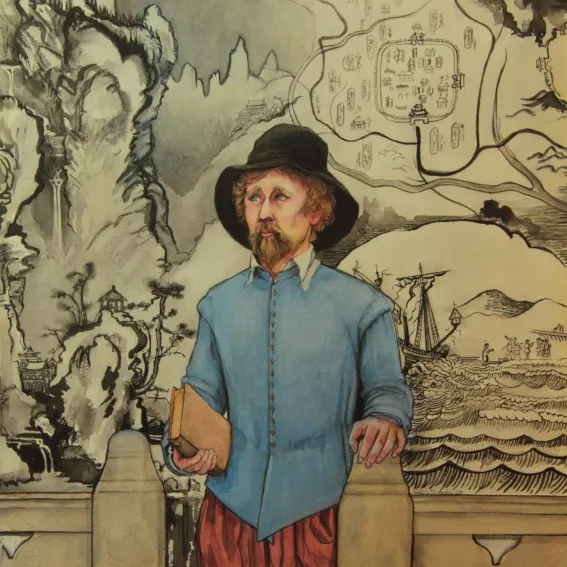Prior to the end of the nineteenth century, Korea was a closed society. Foreigners were not allowed to enter the country and if anyone did enter its borders, they lost their liberty and had to live the rest of their lives in Korea. So in the seventeenth century, at a time when there was a lot of trade between Europe and China and Japan, the country of Korea was still a mystery. A Dutch sailor called Hendrik Hamel was the first westerner to visit the Hermit Kingdom and to write about the country and his experiences there.
On the 18th June 1653, Hamel and the crew of the ship Sparrow Hawk, set sail from Java, Indonesia. They were sailing for Japan. After stopping in Taiwan, they were continuing on their journey when they were caught in a heavy storm that lasted for five days. On 16th August 1653 they were shipwrecked on the island of Jeju, south of the Korean mainland. Of the 64 sailors onboard, only 36 survived.
The Dutchmen were brought before the local governor. They asked to be allowed to sail to Japan, but the governor couldn’t free the sailors without permission from the King of Korea, so a messenger was dispatched to the capital city of Seoul. While waiting for an answer from the King, they were kept under guard, but were well treated by the governor. Two months later, another Dutchman arrived from Seoul. His name was Weltevree and he had also shipwrecked in Korea in 1627. He had been in Korea for so long that he had almost forgotten his native language. He brought bad news for the sailors. The King had refused their petition to be allowed to leave Korea, as the King didn’t want other nations to learn about country.
The next year the kind governor was replaced with one who treated the sailors badly. Six of the sailors tried to escape to Japan on a small boat, but they were unfamiliar with the design of the Korean vessel and were caught in their attempt to leave Korea. They were bound and brought before the governor who punished them severely. Soon after, news arrived from the King that they were called to the capital city. The Dutchmen travelled to the mainland by ship and then on to Seoul on horseback. Arriving in Seoul, the King asked the sailors to sing and dance before him in the manner of their country. Weltevree was still with the sailors and acted as a translator, telling them that they would be bodyguards to the King. But the Dutchmen still wanted to return home.
At that time, Korea paid tribute to China and twice a year an envoy would arrive from China. During the visit of the envoy, the king confined the sailors to their homes so that the Chinese emperor wouldn’t learn of their shipwreck and demand what had been salvaged from the ship be sent to Beijing as tribute. Two of the sailors decided to disobey the King’s order and presented themselves before the envoy. However, the King bribed the envoy to keep his silence and the two Dutchmen were imprisoned and never seen again by their countrymen.
After this the Dutchmen fell out of favour in the court of the King and the next year, 1656, they were exiled to a town in the southern part of the country. They stayed together in the town of Byeongyeong for seven years. During their stay in Korea, the sailors’ meager diet was mostly rice. Growing rice in paddy fields requires a lot of water and before irrigation, Korea was dependent on seasonal rains for its harvest. In 1661 this rain didn’t come and the harvest was very bad. The next year thousands of people died of famine in Korea. The hard times lasted for several years and in 1663 the sailors were ordered to be separated among three towns so they would be less of a burden on any one town to feed.
Hendrik Hamel was sent to the coastal town of Yosu with eleven of his countrymen. Again they were at the mercy of the local commander. Every year or two the commander changed. Some were generous and gave the Dutchmen a good allowance of rice, while others made beggars of the sailors and worked them like slaves. In 1666 a new commander arrived who made their lives so miserable that they decided to attempt another escape. They managed to buy a boat and began to prepare to sail to Japan. Of the 16 surviving Dutchmen, eight of them including Hamel, resolved to escape. On 4th September they set sail for Japan. They arrived on a Japanese island on the 8th. After staying on the island for a few days, they continued their journey to Nagasaki where they arrived on the 14th. Finally they had escaped from Korea after being there for 13 years.
It was another year before they set sail from Japan. They sailed for Java, where Hamel stayed while the others continued home to Holland. Of the eight that remained in Korea, they were finally allowed to leave Korea after the Japanese emperor petitioned for their release. Seven of the remaining Dutchmen sailed for Japan, with one deciding to stay in Korea. On their returned to Holland, Hamel joined them in Java for the journey home. He had left Holland at the age of 20, and it wasn’t until 40 years later in 1670 that he finally returned to his home.

Original painting of Hendrik Hamel by: Natalie St. Martin
https://instagram.com/natalie_st.martin?utm_source=ig_profile_share&igshid=17tn4gyv84gpr